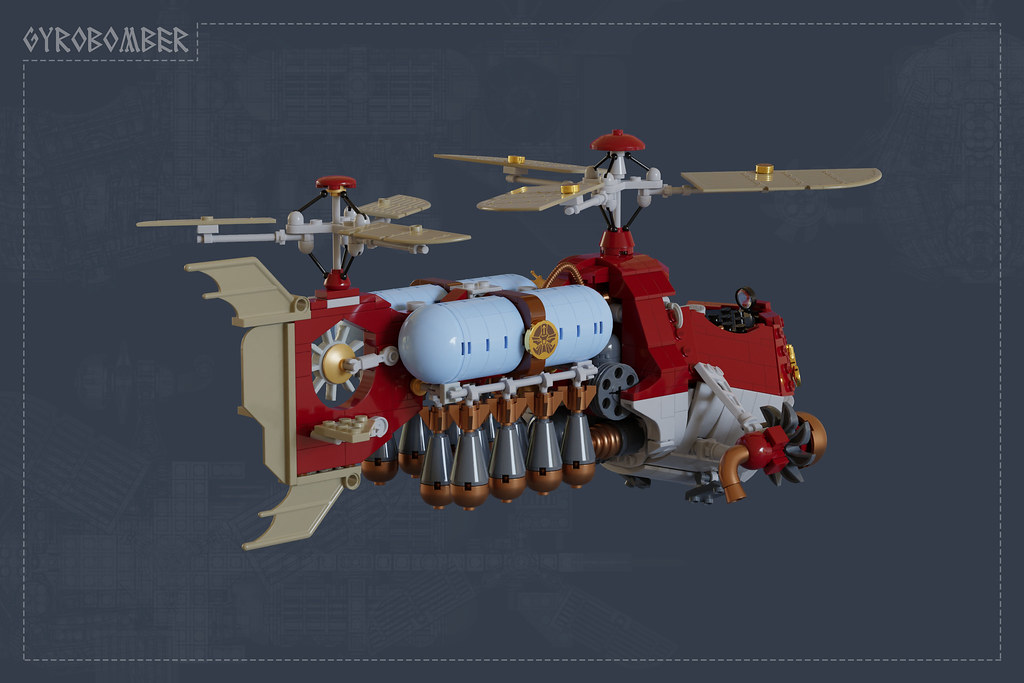Here’s a theory: animals and sci-fi make for a perfect mix. Don’t believe me? Check out this trio of LEGO vehicles courtesy of Devid VII! They are all named after animals, all feature relatively limited colour palettes, and all look amazing. First up is the Froggy, whose ball-jointed feet remind of the Tachikoma that have inspired so many brilliant LEGO creations:
Tag Archives: Helicopter
Apache Helicopter go Brrrrrrr
You know, lore isn’t for everyone. The beauty of LEGO is that it allows us to build the world around us as we see it, and that doesn’t always require a backstory. Having said that, collaborating with others to create a fleshed-out world can be extremely satisfying. I recently talked with self-dubbed LEGO Dad, Simon Liu, about the Apache helicopter model he built for the world-building group, World in Darkness. He explained that the group is focused on factions in a world where the Cold War kept going and that each faction has specific color schemes and gear. Apparently, Oceania’s sand-blue vehicles proved to be a bit “fun” for him due to that color’s limited part diversity, I imagine. Nonetheless, the AH-64X is a beautiful beast. Tiles, slopes, and printed pieces decorate the entire body, carving out the curves and angular sections of the Apache design. Ample headspace is provided for the pilot and gunner in the cockpit. Armed for close aerial support on the front line, this helicopter can protect Oceania’s soldiers day and night. The excellent sticker choices elevate the model, emblazoning it with the Oceania logo and striking lines along the body, wings, and tail sections. The detailed rotor is topped off with a radar dome made with two large dishes, and the turboshaft engines cleverly make use of rotation joint sockets as the intakes.
Simon Liu is a legendary builder and godfather to the upcoming SHIPtember tradition. A master with LEGO, familiar with many secrets of the system, this builder clearly loves his community. Groups like World in Darkness, and many others, give plenty of builders the opportunity to explore their concepts and create new worlds with others. Simon will tell you, he’s happy to see groups like these thriving and loves to see the growth, mentorship, and inclusion shared between the older and younger generations. I personally agree and have long said that the LEGO community is one of the most positive and uplifting groups I’ve ever been a part of. Keep up the good work, LEGO fans.
Warhammer Gyrobomber dishes out the ordnance
Though I’ve never dabbled in the Warhammer universe, I’ve appreciated the art, figurines, and inspiration that it’s provided to its fanbase. This render of a Gyrobomber built by Dwalin Forkbeard was inspired by the Dwarven flying machines in Warhammer Fantasy Battles. Piloted by only one dwarf, the dual-rotor machine features plenty of artillery to lay waste to the battlefield. The curves of the cockpit are wonderfully modeled with brick-built sections and angled plates. Golden and brass details embellish the body and contrast the light and dark bluish-grey pieces of the mechanical sections. The different-sized doors used for rotor blades are an inventive element of the model, as well as the golden crown used as an exhaust port.
The view of the tail reveals the main engine behind the cockpit. I appreciate the variety of pieces that Dwalin used to model this steam-powered design. The attention to detail is fantastic and the form of the model is alluring. The information he provides really shows you how formidable this bomber could be with just one brave pilot.
Building a tiltrotor aircraft using Circuit Cubes [Review]
We’ve occasionally reviewed non-LEGO products on The Brothers Brick, by BrickArms, BrickForge or Citizen Brick for instance; companies that provide accessories for LEGO builds. A new kid on the block is Circuit Cubes. Instead of (accessories for) minifigures they make LEGO-compatible building sets and components, such as electric motors, aimed at teaching STEM subjects to children. They got in touch with me after reading my article on building a remote-controlled vehicle with LEGO Power Functions. They sent me several of their products in return for providing them with feedback. The sets themselves don’t interest me all that much. However, I would like to know how the Circuit Cubes components can be used to enhance my LEGO models. And this may interest those of you who want to motorize your own models too. So, this is not a traditional set review. Instead, I’m going to tell you about Circuit Cubes and how I used them in my own custom LEGO model: an XV-15 tiltrotor aircraft.
A tiltrotor is an unusual flying machine, but the basic idea is simple: with its rotors facing up it can take off and land like a helicopter; with them rotated facing forward they serve as propellers, with the aircraft’s wings providing lift. So, unlike a normal fixed-wing aircraft, a tiltrotor can land in tight spots or on small ships, but in forward flight, it is faster and more efficient than a helicopter. In practice getting this concept to work was difficult, but the Bell XV-15 TiltRotor Research Aircraft first flew in the late seventies and demonstrated that a practical and controllable tiltrotor was viable.
The challenge when building my RC vehicle was hiding the LEGO motors, battery box, Power Functions IR receiver, and what seemed like 2 meters of wiring. I could only fit them inside by building a van with quite a lot of space inside. Because of this experience, two of the Circuit Cubes immediately caught my attention: the Bluetooth Cube and the Cubit. The former is a rechargeable battery pack and Bluetooth controller in one. It has three outputs, remotely controlled via an app (available for Apple and Android). It is rechargeable using a USB cable. The Cubit is an electric motor. What makes these parts interesting is their small size. The Bluetooth Cube has a 4 x 4 stud top and is only two bricks tall. The Cubit has a 2 x 4 stud top and is also two bricks tall. This is much smaller than anything similar made by LEGO, with the exception of old 9V Micromotors.
Continue reading
New LEGO City Police summer sets revealed includes a runaway speedboat, a driller, and lighthouse arrest [News]
We get a look at 3 new City police sets that are slated to be available in August as revealed by retailer Brickshop.nl. All three sets have pieces that range from 160-189 pieces. All three sets feature chase scenes, including a helicopter, a police car, and a boat. Each set comes with two minifigures, each featuring a single police officer and three cleverly named criminals. The prices are only listed in Eurodollars at the moment, and we’ll update them as soon as we get more information.
LEGO Technic Summer 2020 sets fully revealed [News]
Last week we had a first look at the June-December German consumer catalogue images of the upcoming Summer 2020 LEGO Technic sets. Today we get to have a look at the actual box art as revealed by the retailer Meinspielzeug. While we still do not have the regional pricing, part counts are now available for all three sets. These will be available August 1st 2020. We will update the US, UK and Canadian retail prices as we get more information.
Click to see the box art of the new Summer LEGO Technic 2020 releases
Stalking through the night with the MH-47 Chinook
Way back in 2008, I built a LEGO US Army Chinook helicopter. It was one of my first models to be featured on The Brothers Brick, long before I became a contributor. While I do take older models apart every now and then, I kept this one around. It has been sitting on one of my shelves almost unchanged for years. It still looks decent, but LEGO has moved on and so have I. A lot of new parts offer possibilities that I simply didn’t have more than a decade ago. In 2018 I completely rebuilt my Pave Low helicopter, also originally from 2008, using new parts and techniques. Now I have turned my attention to the Chinook.
There was a bit of snag, though. I built the original using old dark grey, a color that LEGO stopped making in 2004 because it looked unattractively dirty or muddy. Muddy is great for a military model, and old dark grey was a nice match for the olive drab color of most US Army helicopters. Unfortunately, since LEGO stopped making this color, none of the new parts, such as curved slopes, cheese slopes, and brackets, that are so useful when building aircraft and helicopter models exist in old dark grey. So, I had to pick a Chinook variant in a color in which these are available.
Fortunately, the US Army’s 160th Special Operations Aviation Regiment (Airborne), nicknamed the “Night Stalkers,” has been flying special operations versions of the Chinook, called the MH-47, for decades. Most of these are black, which is perfect in terms of parts. They also have a lot of features that regular Chinooks usually lack, such as much larger extended-range fuel tanks alongside the cabin, an air-to-air refueling probe and radar and laser warning receivers and various other antennae dotted around on the outside. Adding all of those details made this a more challenging and interesting build. The end result looks like an angry beast.
Guns? Check. Rotors? Check. All systems go!
Sometimes the inspiration for a LEGO build comes from the builder’s head, or from some media franchise, or from some particular piece that suggests a creation just by its shape. Sometimes it is all of those, as this build by Andreas Lenander demonstrates. The build was begun by thinking about the rim from the Harley Davidson Fat Boy, which led to thinking about the airships from Avatar, which led to a very cool, very capable-looking heavy gunship. A couple of these bad boys cresting the ridge, launching missiles from the under-wing batteries, spraying lead from the nose mounted gatling gun, would be sure to send the enemy running in fright. It is like a combination of the A-10 Warthog and the AH-64 Apache, and I love it.
Besides the rims, the build uses some of the grenade tips that I associate with newer Batman sets as its missiles, stuck into Technic pins and then stuck into the underside of bricks. It is a simple connection, though slightly “illegal“, but it is a great one to remember when trying to reverse stud direction. The Technic axle connector on the nose looks great, too, with the four notches giving the impression of multiple barrels on the machine gun. It is a bit light on greebling, despite what one might expect from a sci-fi build, but I think it is more appropriate to make it look smooth and professionally engineered, rather than cobbled together. After all, if you want to take down some Na’vi with your military-industrial complex, you have to look sharp and pack a big punch.
How to build a Pave Low helicopter with LEGO: Part 3 [Feature]
It’s done! Building my Transforming Bumblebee distracted me for a bit. However, I actually completed my Pave Low helicopter before the Beetle. In parts one and two of this series I explained how this sort of model has gotten a lot more complicated. Thanks to newer parts and techniques, the simple solutions I would have been happy with ten years ago just don’t hack it anymore. In this third and final part, I finally unveil the finished article.

Click here to continue reading…
How to build a Pave Low helicopter with LEGO: Part 2 [Feature]
Progress on my Pave Low helicopter has been slow. In Part 1 of this series, I explained how I am using new parts and techniques to build an up-to-date version of the model I built ten years ago. In this second part of a short series, I’ll explain one of the difficulties I ran into. I plan my models such that actually building them is usually a fairly straightforward process. I used my old model as a template and had an idea of how to do most of the other things in my head. As a result much of the model so far indeed came together quite easily.
Note the words “usually”, “most” and “much” in those last three sentences. The tail on my old model was quite narrow and I wanted the new one to be wider, using curved slopes and bricks. However, the fin is tilted aft at a roughly 45 degree angle, with a horizontal fin on top of it. I only had a loose idea of how to this. Actually building it took about eight frustrating hours of tinkering and trial-and-error. The diagonal part is attached to the tail boom using clips and plates with bars. The horizontal fin uses a similar attachment. A major problem was positioning all of this at the proper angle. I wanted as few visible gaps as possible and the tail should also be reasonably sturdy. This was asking rather a lot. The result is an improvement over the old one, but I’m still not completely happy.
How to build a Pave Low helicopter with LEGO: Part 1 [Feature]
A few months ago, I wrote three articles on how I built the E-1 Tracer aircraft model. I haven’t built much in the intervening months, but recently I have started on a new project: an MH-53M Pave Low helicopter. This is a somewhat different cup of tea. It’s not a fixed-wing aircraft and I am not starting from scratch. Instead, I am starting with an old model that I built ten years ago.
This means that there is a lot less planning involved. The proportions of the old model were pretty much spot-on, but there are many parts and techniques that didn’t exist or weren’t possible ten years ago. As a result, the old model looked, well, old.
In this and subsequent articles, I’ll go into how I am building this new version and how newer parts and techniques change how I approach the design.
Continue reading
Metal Gear Solid V’s Pequod UTH-66 Blackfoot in LEGO
When you need to get somewhere fast in Metal Gear Solid V, you can always count on Pequod, the callsign for the Solid Snake’s chopper transport. Seen here in its sea-grey color-scheme, the fictional UTH-66 Blackfoot is a huge helicopter that draws heavily on real-world inspiration, and nowhere have we seen a better LEGO version than this one by Marius Herrmann. He’s has made sculpting the compound curves of the accurate minifigure-scale cockpit look easy.
Outfitted with multiple weapons and a long refueling probe, this LEGO chopper is one of the best pieces of realistic military machinery we’ve seen recently.















